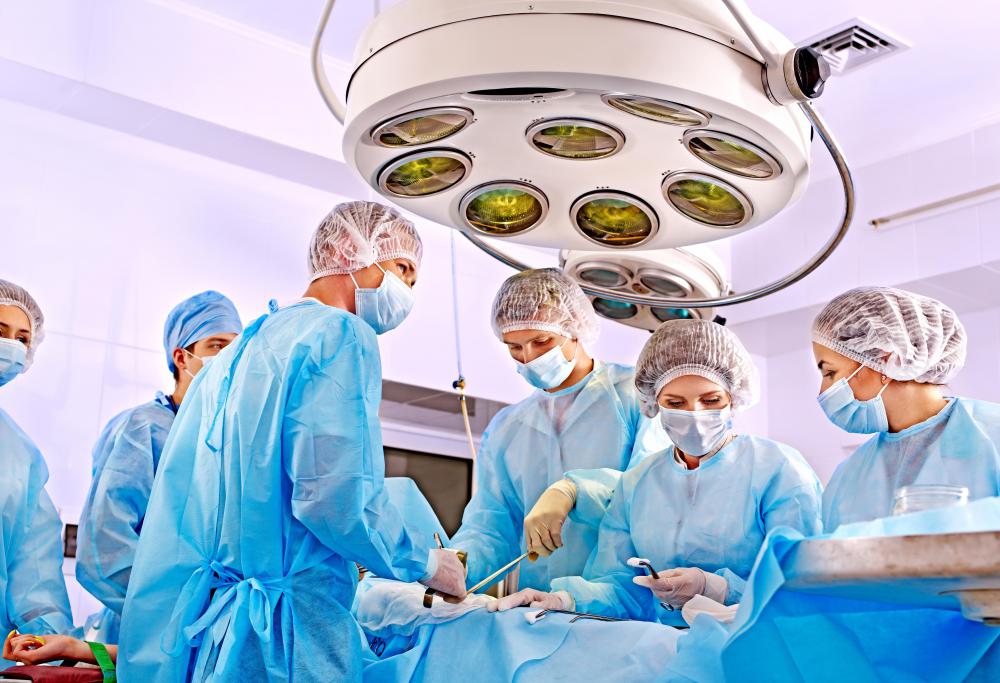At TheHealthBoard, we're committed to delivering accurate, trustworthy information. Our expert-authored content is rigorously fact-checked and sourced from credible authorities. Discover how we uphold the highest standards in providing you with reliable knowledge.
What is a Hiatal Hernia Repair?
Hiatal hernia repair surgery is a medical procedure carried out to repair an abdominal condition called a hiatal hernia. This condition can cause chronic severe acid reflux, abdominal pain and other symptoms. Hiatal hernia repair surgery is required when the condition is severe enough that symptoms cannot be controlled by medication. This medical procedure is sometimes called anti-reflux surgery, because it reduces reflux symptoms caused by the hiatal hernia.
The diaphragm is a very large, thin muscle that is shaped like a dome. This muscle separates the abdominal cavity from the chest cavity and sits just beneath the lungs. The diaphragm is important in breathing, because it helps push air in and out of the lungs. In the center of the muscle is a hole known as the hiatus, which allows the esophagus access to the stomach. In a hiatal hernia, the stomach muscles surrounding the hole in the diaphragm bulge upward, allowing the top part of the stomach to protrude through the hiatus.

Hiatal hernia can be caused by injury, muscle weakness or intense pressure put on the muscles, such as when lifting heavy objects. In addition, some people are born with a large hiatus, which increases the risk of hernia. Small hernias generally do not cause symptoms. Larger hiatal hernias can lead to nausea, belching, difficulty swallowing, acid reflux and chest pain. These symptoms might be worse after eating or when lying down.

Medications to treat hiatal hernia include over-the-counter antacids and prescription medications to reduce or block stomach acid production. This allows time for the esophagus to heal. These medications are used to treat the symptoms of hiatal hernia but cannot help repair the hole in the diaphragm. If these medications are not able to help ease the symptoms, hiatal hernia repair surgery might be indicated.

In hiatal hernia repair surgery, the hernia is repaired by first returning the muscles and top portion of the stomach to their correct locations beneath the diaphragm. The hiatus of the diaphragm is then stitched to reduce its size and prevent recurrence of the hernia. If gastroesophageal reflux is severe, a procedure called fundoplication also might be performed. In this procedure, the top part of the stomach is wrapped around the lower portion of the esophagus and stitched in place. This reduces acid reflux by putting pressure on the esophageal sphincter muscle that separates the esophagus and stomach and helps keep the muscle closed.

Hiatal hernia repair can be an open procedure in which a relatively large incision is made in the abdomen to access the stomach and diaphragm or might be carried out using laparoscopy techniques. In the latter procedure, three or four very small incisions are made in the abdomen. Surgical tools and a light source are threaded through the incisions, as is a mini-camera that relays images from the interior of the body to a video monitor that the surgeons view while operating.

Laparoscopic surgery is generally preferred over open surgery because of its faster recovery time. People who undergo laparoscopic hiatal hernia repair surgery can leave the hospital in one to three days and return to work in just two or three weeks. If a patient undergoes the open surgery technique, he or she will spend up to six days in the hospital and might not return to work for four to six weeks after surgery.
Both types of this surgery have a risk of complications. The two most common are gas bloat, which causes bloating after meals and might also cause pain when belching, and difficulty or pain when swallowing. Most people find that these issues improve greatly within a few months after surgery.
AS FEATURED ON:
AS FEATURED ON:















Discuss this Article
Post your comments